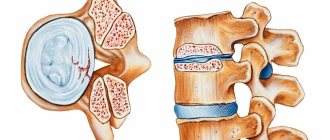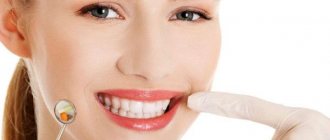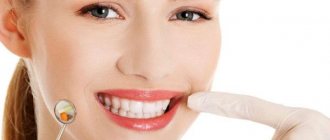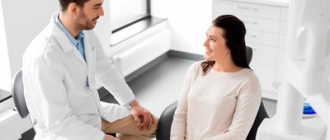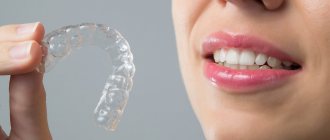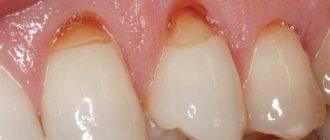Clinic “No Hurt!”
Enlarge
A patient comes to the doctor with caries. Or, during an examination, the doctor discovers caries. Treatment is prescribed. Dental tissue damaged by infection is removed and the tooth geometry is restored using a filling. The nerve of the tooth is not affected during caries treatment and the tooth remains alive. The patient goes home, but the tooth does not allow itself to be forgotten. It hurts to bite. It hurts to chew. Pain occurs when biting, pressing, or pressing on a tooth.
We addressed this topic in the article Tooth hurts after filling. In this publication we will reveal the causes of toothache under a filling after caries treatment.
Main reasons
Pain is a kind of “alarm” from the body, drawing attention to malfunctions in its functioning. The oral cavity is no exception: if a seemingly healthy tooth hurts when pressed, this indicates that something has happened to it. As a rule, the reason is damage to the crown, root, gums, or the presence of an inflammatory process. But provoking factors can be very diverse: injuries, infections, insufficient hygiene and even medical errors. Let's look at each case in more detail.
Why it hurts to press on a tooth - the main reasons
The causes of pain in a molar, incisor or canine when pressing on it can be very different. Below we will talk about the most common ones.
Increased sensitivity
If unpleasant sensations are associated precisely with this, then they can remind of themselves without any serious reasons. A person simply needs to clench their jaws more tightly to experience discomfort. In such a situation, you should use special toothpastes and remineralizing gels. Pharmacy mouth rinses will also help improve the situation.
If it is not possible to eliminate the manifestations of the pathological condition using standard hygiene products, it is recommended to make an appointment with a dentist. The dentist will treat the teeth with a fluoride-containing strengthening composition, which will improve the situation.
Traumatic injuries (history or recent)
A very common reason. Usually a person who has suffered a jaw injury understands what causes his discomfort. It is important to realize that injuries are not necessarily the result of falls or fights. Sometimes it's enough to eat a handful of nuts or chew crackers to get a problem.
When exposed to mechanical stress, cracks appear on the enamel surface. They are the ones who cause unpleasant dental symptoms. It is not possible to close them on our own. It is imperative to visit a doctor so that he can provide the necessary treatment.
Periodontitis
Complication of advanced caries, injury or poorly performed dental treatment. With it, the periodontium becomes inflamed - a narrow space located between the crown and the socket. The pathology occurs in acute or chronic form.
Therapy for periodontitis must be comprehensive. Need to:
- get rid of the inflammatory focus;
- clean the dental canals and create conditions for the unhindered outflow of exudate;
- administer antibiotic therapy;
- use medicinal baths.
Good dynamics during the disease are provided by UHF to the affected area.
Gum inflammation
Another reason why a tooth hurts when pressed. Here you need to carry out a differential diagnosis - first press on the gum, and then on the crown. If the problem is damage to soft tissues, then a negative symptom will arise precisely when pressing on them.
Treatment for gum inflammation includes:
- carrying out anti-inflammatory baths;
- exclusion of irritating factors that negatively affect the gums;
- carrying out physiotherapeutic procedures, gum massage;
- vitamin therapy;
- mouth rinse;
- oral administration of medications that help to quickly relieve inflammation.
Poor quality dental prosthesis
It is very important that the installed structure exactly matches the characteristics of the patient’s oral cavity . It is unacceptable for artificial units to be higher or lower than those given by nature. This will create unnecessary pressure on antagonistic neighbors.
It also happens that the doctor performed poor-quality root canal treatment before prosthetics. This led to inflammation. Then you will have to remove the prosthesis and re-treat the canals, and then repeat the prosthetics from the very beginning.
Of course, such situations are very unpleasant and leave a lot of negative emotions and experiences in the patient’s memory. That is why it is so important not to go to a clinic where it is cheaper, but to contact experienced doctors who guarantee the impeccability of the final result.
Cyst
They speak of a root cyst when they see a spherical formation filled with liquid contents . It appears after an injury, as a result of infection of the root canals, due to the introduction of infection into the periodontal zone by a non-sterile medical instrument.
It is important to establish the true cause of the cyst and carry out its step-by-step treatment. When the situation returns to normal, pain symptoms will cease to bother you.
Caries
It would seem that it is not difficult to notice caries and understand that it is the cause. But it is not always the case.
If the carious cavity is at the spot stage , it may be completely invisible to a person. The situation is similar if the “hollow” is located between neighboring units.
To understand the root cause of the problem, you need to conduct a dental examination. To reduce the risk of cavities, you should have checkups at your dentist's office every six months.
Pulpitis
A disease that every person faces sooner or later. It affects nerves and blood vessels located in the root system. With pulpitis, painful symptoms occur:
- when pressed;
- when eating cold or hot food;
- when trying to chew something hard.
Treatment is carried out under local anesthesia. The doctor opens the upper part of the crown and puts in the medicine. After the specified period, the patient comes for a follow-up appointment. Then the medicine is removed, the canals are cleaned, expanded and sealed. Finally, a permanent filling is installed.
It is very important not to delay treatment of pulpitis. This disease is very insidious. Among its consequences:
- destruction of bone tissue;
- periostitis;
- periodontitis;
- destruction of the ligaments holding the canine, incisor or molar (this leads to its loosening and premature loss).
The tooth hurts when you press on it: after depulpation (nerve removal)
The pulp is nerve fibers and vessels that provide sensitivity and nutrition to the tooth. After their removal, the tooth is considered dead, and it may seem that this is the solution to any problem, because a dead tooth is unlikely to hurt. This is wrong. A pulpless tooth can be disturbing for several reasons:
- if the dentist, while cleaning the canals, punctured the root;
- when the thin end of the endoscopic instrument breaks off and remains inside the canal;
- in case the dental canals have not been completely cleaned and an infection remains in them.
In the first two cases, the pain is quite sharp: the pulpless tooth hurts not only when pressed, but even when touched lightly. If the dentist cleans the canals poorly, pain appears after some time. In any case, a tooth without a nerve that causes discomfort is a reason for a repeat visit to the dental office.
How to relieve pain
If a tooth hurts severely after treatment of pulpitis, taking a pain reliever (Analgin, Ibuprofen, Ketolac, etc.), rinsing the mouth with an antiseptic solution or a warm herbal decoction of lemon balm, sage, oak bark, chamomile, will help temporarily relieve the pain symptom and alleviate the condition. calendula.
It is strictly forbidden to heat a sore tooth, apply alcohol or garlic compresses to the gums, or take antibiotics or aspirin.
Tooth hurts when pressed after filling
Slight pain after the doctor has given a filling to the patient is normal: during the sanitization of cavities affected by caries, the tissues receive microtrauma. The condition is easily treated with analgesics and goes away on its own in 2-3 days. But if a filled tooth hurts when pressed hard enough, then the problem is one of five reasons:
- high filling - the occlusion is disrupted, the tooth experiences excessive pressure and becomes painful;
- the dental pulp was burned when the filling was treated with a photopolymer lamp;
- a gap has appeared between the filling and the enamel, into which bacteria and food particles have entered, causing inflammation;
- the cavities affected by caries were not drilled out thoroughly enough, and it reappeared;
- I developed an allergy to the filling.
If the tooth under the filling hurts when pressed, this means that you need to make an appointment with the doctor again and have it filled again.
The first group includes:
Caries
A carious cavity is a depression in the hard tissues of the tooth that appears as a result of their destruction. Food or drinks (most often cold) enter the cavity and cause short-term (several seconds) pain. If food is retained in the carious cavity (especially sweet food), the pain may last longer.
Seal defect
If part of the filling (or part of the hard tooth tissue around the filling) placed previously breaks off under the influence of chewing load, a part of the tooth that is more sensitive to the effects of food is exposed.
Chronic apical periodontitis in the acute stage
It sounds scary...and in reality it is no less terrible. The mechanism of pain in this case is quite simple. Around the apex of the root, surrounded by a dense bone plate, the inflammatory process is activated. Inflammation in all parts of our body proceeds along approximately the same path and is characterized by an increase in the volume of inflamed tissue (due to blood flow to the affected area). And if this happens, for example, when a hand is bruised, then we will see swelling, that is, an increase in volume. Now let’s imagine the formation of a “swelling” in the area of the root apex surrounded by a dense bone plate... there is no room for the incoming fluid, the nerve endings are compressed, and here you are also trying to chew a delicious steak!
Periodontitis
One of the causes of tooth pain is periodontitis.
The thing is very unpleasant (like most dental diseases). It is characterized by a long-term, most often sluggish inflammatory process of all tissues surrounding the tooth (gums, ligaments, bone surrounding the tooth), leading to their atrophy (reduction). As a result, the tooth becomes mobile and cannot withstand the chewing load, which is indicated by pain.
Functional overload
Each of our teeth, depending on the function it performs, is designed for certain chewing loads. However, if for some reason the number of teeth decreases (extraction, injury, etc.), the remaining ones begin to experience increased chewing pressure (for themselves and for the lost ones). Such excessive load leads to loosening of the tooth and the appearance of the symptom we are discussing. Only high-quality prosthetics will help solve this problem.
Injury to the gingival papilla by hard food
The reasons for this phenomenon may be:
Large distances between teeth (diastema and trema). They can be either physiological in nature (features of the anatomical structure) or pathological (for example, “divergence” of teeth during periodontitis);
Poorly restored contact point
A contact point is a point or area through which adjacent teeth contact each other and through which chewing pressure is distributed. If the carious cavity was located on the side surface of the tooth and after filling it, the contact point was not properly restored, then food will get clogged between the teeth when chewing, injuring the gingival papilla. Hence the pain. This reason relates more to the second group, so let’s move on to it.
The treated tooth hurts when pressed after canal filling
Working with roots requires precision and accuracy from the doctor. If he incorrectly assessed the depth of the canals, then the following complications cannot be excluded:
- a tooth without a nerve hurts when pressed if the filling material extends beyond the apex of the root, gets into the gum and puts pressure on it;
- when the channels, on the contrary, are not completely filled, inflammation may begin in the voids over time. If a lot of time has passed after visiting the doctor, and the tooth aches and hurts, then the problem is the unsatisfactory filling of the canals.
The tooth under the crown hurts when pressed
Crowns and bridges can also cause many unpleasant moments for their owner. Normally, you may feel discomfort under the crown for several days after installation, but as you adapt, the pain gradually goes away. If a month later the tooth still aches a lot and hurts when pressed, and also if the pain under the crown appears suddenly, this is a reason to consult a doctor.
There are four main reasons:
- the crown became loose, food particles and plaque accumulated under it, and inflammation began;
- the crown is cracked or split;
- the tooth is poorly ground under the crown;
- The shape of the crown is chosen incorrectly; it puts pressure on neighboring teeth or gums.
Prevention of pain after dental prosthetics
As with all dental procedures, the simplest and cheapest solution is to prevent the problem from occurring in the first place.
- If you have dental crowns or bridges, you should have a dental checkup at least once every 6 months. The dentist will monitor the condition of the teeth under the dentures, since they are initially at risk.
- Hardware cleaning of bacterial plaque and possible food debris will prevent the development of infections and caries; this procedure is mandatory along with normal home oral hygiene, including brushing teeth and using dental floss.
- It is also important to monitor the integrity of the dentures - avoid hard foods and excessive loads so that the denture is not damaged or its tight fit to the stump of the supporting tooth is broken.
Don’t endure pain after dentures - contact the orthopedists at the ILATAN family dentistry closest to your home to get advice and help. Registration is available by phone +7 (495) 748-50-50.
A healthy tooth hurts when pressed
What should you do if, when pressed, a tooth that has not been sanitized, depulped, drilled or loaded with a crown hurts? Yes, this happens too. Here are a few reasons why a seemingly healthy tooth can be painful.
- Periodontitis. This is an inflammatory disease of the tissues around the teeth. When pressed, both the gums and the tooth hurt at the same time. If no action is taken, progressive periodontitis will lead to a reduction in the volume of the gums and even bone, and then the tooth will become loose and may fall out.
- Excessive enamel sensitivity. It is provoked by chemical teeth whitening, after which even a tooth with a nerve can ache when biting or drinking cold and hot drinks. Teeth with filled canals do not have this problem. You can make your enamel less sensitive at home by using remineralizing gels and toothpastes.
- Removal of a tooth. After surgery, the adjacent healthy tooth may hurt. This is due to damage to soft tissues and does not require any additional therapy other than that prescribed by the doctor.
Pain in teeth when chewing, what can cause it and how to treat it?
Toothache is dangerous and insidious; it can manifest itself in various ways and be a signal of a serious illness. In some cases, pain appears suddenly and for a short time, and sometimes it is present for a long time and causes great inconvenience and discomfort. Pain may occur during chewing, when pressing on the tooth or when tapping on it. Each type of toothache is a sign of some kind of inflammatory process in the oral cavity or tooth.
Pain in the teeth when chewing is one of the types of toothache that causes significant discomfort when eating. There are several reasons that can contribute to this type of pain.
Causes of toothache when chewing:
- presence of caries;
- crack in the tooth;
- violation of tooth enamel;
- damaged filling or crown structure;
- the presence of a damaged dental nerve;
- formation of a cyst in the tooth;
- periodontitis;
- periodontitis;
- pulpitis, etc.
Toothache when chewing is a signal of one of these processes. It is very difficult to independently determine the cause of pain, so if you have such pain, you must definitely seek help from a specialist so that he can make the correct diagnosis and prescribe treatment as soon as possible. Lack of proper and timely treatment can lead to unwanted complications and the development of serious diseases.
What should you do if your tooth hurts when you press it?
Pain almost always accompanies the rehabilitation period after dental surgery. If the patient follows the doctor’s recommendations, the discomfort disappears on its own after 2-4 days, however, in some cases, pain can signal complications. The patient should return for a follow-up appointment if:
- immediately after the anesthesia wears off, severe and sharp pain appears;
- More than a week has passed after treatment, but the toothache does not go away;
- The rehabilitation period went well, but after 1-3 months pain appeared again.
The most important thing is not to endure, but to figure out where the pain comes from.
Ways to treat and reduce tooth pain when chewing
If you experience pain while chewing food, you should immediately seek help, without waiting for the pain to go away on its own or for additional unpleasant symptoms to appear, such as temperature and swelling, which indicate the presence of a significant inflammatory process in the body. However, if it is not possible to go to the dentist in the near future, you can independently relieve the pain and stop the development of inflammation with the help of a few simple procedures.
Ways to reduce pain when chewing:
- rinse the mouth with herbal tinctures or soda solution;
- make tooth lotions from mint, cloves or sea buckthorn oil;
- After each meal, use dental floss and rinse your mouth to get rid of food debris;
- to disinfect the oral cavity, keep onion peel tincture in your mouth for 20 minutes;
- for acute pain, you can take a painkiller, for example spasmolgon, analgin, nurofen, etc.
These methods will help reduce pain before visiting a doctor. However, it is impossible to cure the cause of toothache with their help, so it is necessary to seek qualified help as soon as possible in order not to aggravate the situation and prevent the development of other oral diseases.
